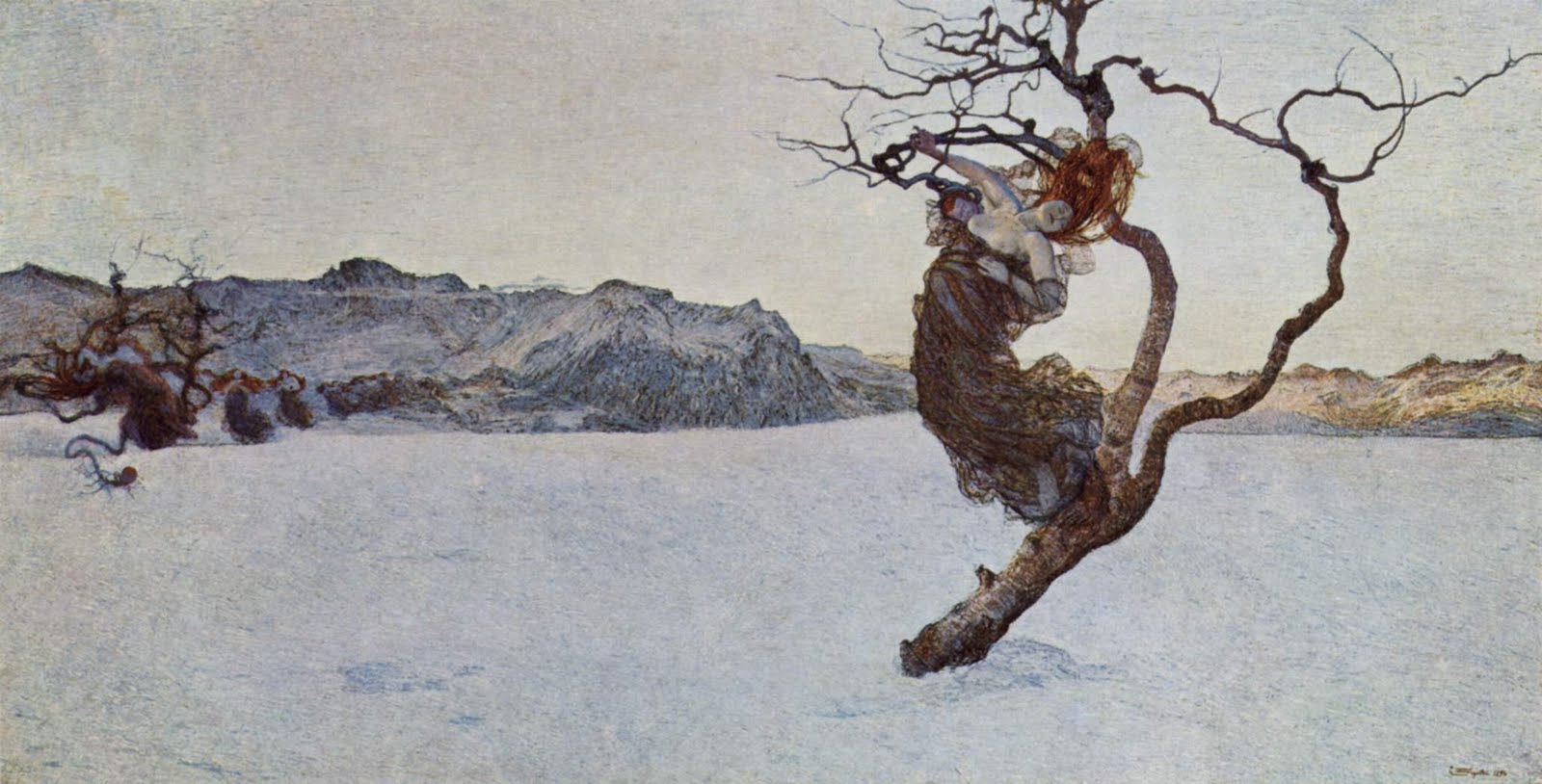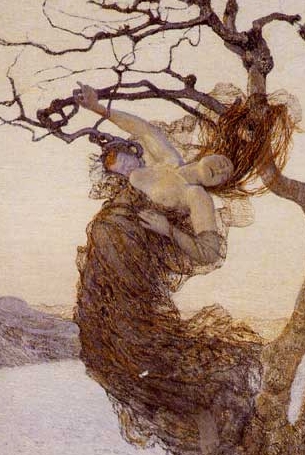A New Look at Segantini’s “The Evil Mothers” Series
By Anat Moberman
Between the years 1891-6, Giovanni Segantini, who died on 28 September 1899, painted a large series of paintings dealing with the subject of mothers rejecting what was then seen as their natural destiny – motherhood – either by refusing to conceive or through terminating their pregnancies. Most critics have seen the paintings as an expression of the Decadent atmosphere of the Fèmme-Fatale image of a sexually motivated, free, and murderous woman. Even though the women in the series are beautiful, naked redheads, they are obviously not Fèmme-Fatales, often described as having sado-masochistic relationships with male victims, or as beautiful, animalistic creatures, characteristics absent in Segantini’s paintings. Instead, the artist presents the women in the context of Motherhood to imply that Woman’s sole purpose and destiny is in Motherhood and that women who refuse their “natural” destiny to become mothers will be punished.
Letters indicate that Segantini was inspired by Luigi Illica’s (1857-1919) poem “Nirvana” and its conception of Nature. According the poem’s title, Illica adopted the Buddhist concept of Nirvana, meaning “shutting down,” which refers to the Buddhist’s state of mind following enlightenment, a state of emptiness, nothingness, lack of joy, sadness, suffering, and pain:
Over there, within the infinite light blue space
A glamorous Nirvana
There, behind the rugged mountains and gray rocks
Wonderful Nirvana
Thus, the poem’s landscape becomes a metaphor for Nirvana’s mental state, with its lack of drama; an eternal snowy, lifeless Nature, where trees are naked and not blooming. This silent Nature becomes an allegory for the Evil Mothers’ mental state. Segantini’s first painting in the series, The Punishment of Luxury (1891), reflects Illica’s text. Both poem and painting present a snowy landscape with denuded bushes, whose bare branches entangle the hair of bare chested women hovering prone in the air. The poem also makes a correlation between the frozen landscape and the emotional and physical states of the women:
Thus the Evil mother in a bluish-grayish Valley
Because of an eternal glaciers
Where no branch or flower is blooming
Circular is being pushed
Does not give a smile, a hug, to her only son
Oh useless mother
A soul wasn’t blooming from your kisses,
Oh useless mother
So is the agony of silence
Being dragged and pushed
A frozen development with watery eyes
glaciated shapes
Look at her! Restless
as madness! … And she is tormented with silence…
In a letter to Vittore Grubicy de Dragon (1851-1920), dated 1891, Segantini emphasized the role of Nature in his painting’s iconography: “The lusty women I have punished in nirvana of snow and glaciers. These are the figures hovering in space without wings, surrender to pain, carried up to the setting sun, and this is the meaning of the painting, the color is a symphony of whites and blues, silver and gold.”
While The Punishment of Luxury demonstrated Segantini’s attachment to the first part of Illica’s poem, another painting titled The Evil Mothers (1894) highlights the end of the poem – woman’s surrender to a more powerful Nature and her transformation to become a mother. As described in both poem and painting, a woman hangs on bare tree branches, out of which a baby’s face appears, described as “hungrily breast sucking / and kissing.“ Similar to the earlier picture, the snowy landscape contains feminine figures tied up to tree branches. But the flooding blue color of the earlier version gives way to a white, snowy color.
In his diaries, Segantini wrote that while the white neutral snowy color symbolizes death, it can also symbolize life. Thus, the snowy landscape and tree correspond to the poem’s analogy of landscape and woman, according to which the barren woman, who surrendered to her instincts to becomes a mother, appears as a bare winter tree sprouting leaves when in springtime. One can therefore conclude that the tree, which is a recurring and important theme in the poem and Segantini’s paintings, can be seen as the Tree of Life. The woman’s face reveals that, despite the tension in her arched body, her face is completely relaxed, free of pain and suffering.
Thus, the term “Nirvana” not only refers to the landscape, but also defines the state of the woman herself, who, fulfilling her destiny as a mother, has stopped suffering and reached the state of Nirvana. Evidence of this interpretation can also be found in the additional title given to the painting, “The Nirvana of the Lustful,” ignored by writers on Segantini’s work like Quinsac and Damigella. Indeed, Nature as seen in the Evil Mothers series is not only a naturalistic description of Engadina’s landscape, Segantini’s residence at the time, but also presents a symbolic nature referring to the cyclical nature of life, the transition from infertility to fertility, sin and redemption, birth and renewal.
The Evil Mothers (Le cattive madri: Il nirvana delle lussuriose ; “Le lussuriose ; L’infanticide”), 1894, 120 X 225 cm. Oil on canvas. Vienna, Belvedere Museum, Neue Galerie.



Located in Belvedere Museum in Vienna (not Kunsthistorisches Museum, as mentionned)
Thank you for your comment, the post had been amended.